
Tom Blanton Executive Director of the National Security Archive, Washington, D.C. |
||
The list itself brings us to the interesting question about the ways in which many of these criminals find protection. Various countries are complicit here, as we have seen. I would advocate taking a rigorous look at the United States National Security Act of 1947, and its so-called "100 persons" provision, which allows us, every year, to bring in and shelter 100 individuals considered to be assets to our intelligence operations. Living here under that law is Haiti's Toto Constant. A small-fry compared to Cedrás, but still a leader in the death squads, Constant was on the payroll of the CIA, and is now in the Witness Protection Program. We really should have a detailed study of the "List of 100" for every year that the NSA has been in force. We have a right to know how that law has been used. I would also like to see a list of vulnerable sitting heads of state, it being understood that these prosecutions would would be extremely difficult to obtain. On a scale of horror, China's Jiang Zemin, has to be mentioned for having created what is believed to be the largest gulag system in the world. In 1999, the Guatemalan Historical Clarification Commission made a finding of genocide against Ríos Montt, for the slaying of tens of thousands of Mayan Indians. Fidel Castro should be noted for extrajudicial killings from 1959-1961. And Saddam Hussein for gassing the Kurds.
Tom Blanton is the Executive Director of the National Security Archive, Washington, D.C. |
